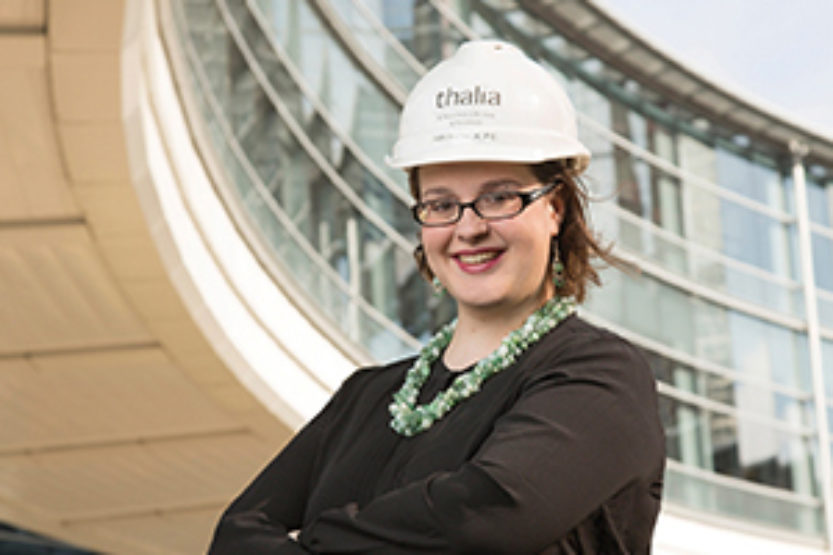Alumni Interview: Amy Barr Patrick
 Amy Barr Patrick, MS ‘06 ENG, 32, is principal and CEO of Thalia Engineering Studio, a structural engineering firm she founded in Spring, Texas. (Image by Bruce Bennett)
Amy Barr Patrick, MS ‘06 ENG, 32, is principal and CEO of Thalia Engineering Studio, a structural engineering firm she founded in Spring, Texas. (Image by Bruce Bennett) I grew up in Dallas; my father was a doctor, and my mother a psychologist, but I was never drawn to medicine or health. From the time I was little, I was interested in buildings. I played with Legos. I drew pictures of buildings for my friends. And I loved math. My favorite book was Why Buildings Stand Up: The Strength of Architecture, by Mario Salvadori. It had pictures and diagrams of cathedrals and bridges and the Eiffel Tower, and I would just pore over them.
I received my undergraduate degree in civil engineering from Rice, then came to Illinois after being told that the program in structural engineering was the best in the nation. I had a great experience. My overwhelming memory is of all the wonderful research going on. There was a fantastic three-story strong wall and a really impressive strong floor to which we could attach full-scale columns and beams and test them to failure. Being involved in research on that scale is awe-inspiring. You’re on the forefront of answering important questions about how our buildings and bridges behave. A graduate of the program, Bill Baker, MS ’80 ENG, came back and discussed his work in Dubai helping to build the Burj Khalifa, the largest building in the world. It made a huge impression on me.
Structural engineering is a very concrete exercise—often literally. But it also has a spiritual element. There is something so basic about structures—we live in them, work in them, worship in them. To see people interacting with something you’ve helped build is just so fantastic.
I worked on the Texas Children’s [Hospital] Pavilion for Women in Houston, and now when I see the pictures of nurses and the doctors who work there who love the facility, and the expectant parents who put their trust in it, and the babies who are born there, I feel like I’m a part of those experiences. And that’s so inspirational. It’s like we help build the world.
Structural engineering is a very concrete exercise—often literally. But it also has a spiritual element.
Many people don’t know what a structural engineer does, or how what we do differs from what architects do. An architect designs a whole building, everything from the overall look of the thing to the plumbing. Structural engineers figure out the mechanics of what’s necessary to hold that building up. I was tempted to become an architect, but I was too attracted to the science and the math. It was just so cool to sit down with a pencil and a piece of paper and to do the calculations and say, “Okay, we’ll put a beam here.”
Too often we are hired after an architect has a design and a list of features they want to put in the building. We have to do the calculations and say, “No, no, no.” I would prefer to start working with the architect earlier, to blend form and function, to be able to say to the architect, “You want to do that? I can help.”
Recently I opened my own structural engineering firm, the Thalia Engineering Studio—Thalia being one of the nine muses from Greek mythology, the one in charge of architecture and comedy. My decision to do so was very much influenced by the U.S. State Department-sponsored mission on which I went to Brazil in 2011. We studied what they do to recruit and retain women who work in the fields of science, technology and math. They do a good job of that in Brazil. We in the U.S. don’t. The invitation was almost serendipitous. A friend sent me the application and I applied, and the next thing I knew, the State Department was on the phone. Much to my surprise, the firm where I worked gave me a very hard time about the trip. “This isn’t your job, you’re an engineer, you’re not involved with recruitment.” I went anyway, and I began to think about how short-sighted they were, and how little commitment they showed to my development. I was resigned to the realities of being a woman in this field—you hear it everywhere, a woman in math or science or engineering has to work twice as hard as a man to get half the recognition, and it’s true. It was astounding to meet with Marcos Cortesao, program director for the Brazilian Academy of Sciences, and hear him say: “The first thing we needed to find out is what we were doing to alienate half our work force.”
That hit home. I opened my own place, determined to make it a case study in how to run a firm that is pro-woman. And the key to that is flexibility, so that female workers are free to manage their own time. It was an incredible leap of faith, but my family supported me, and so far it’s worked well.

